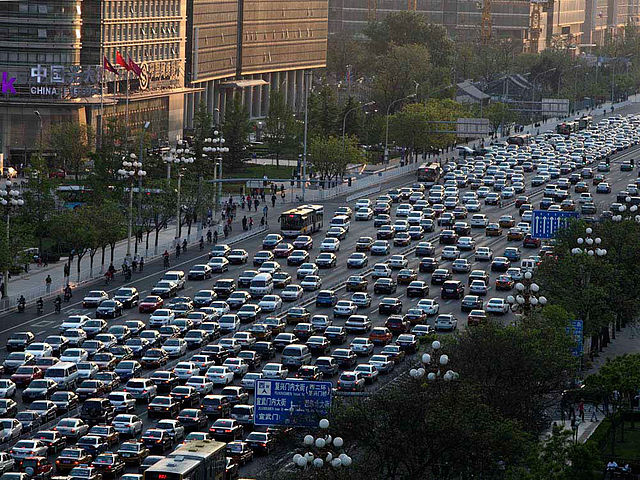Traffic in China’s cities is crazy, and the incessant construction of bridges, overpasses, and subways has only served to exacerbate the problem in the short term.
Once the price of cars was within the average Chinese person’s budget (some time around 1995-2000), car ownership in China boomed. The infrastructure could not keep up, and heavy traffic ensued. The construction of a society based on the automobile akin to the U.S. continues in China, as dealerships are built around the country to sell the cars that will one day drive on all the roads newly and to be constructed. Major Chinese cities from Ningbo to Dalian to Qingdao to Xiamen to Chengdu have been torn up and re-made in a modernization drive as huge bridges, ocean tunnels, and highway overpasses are nestling next to new roads lined with shopping malls and rows of high rise flats that make up the skyline of modern China.
The strategy of requiring Joint Venture factories with the likes of GM, Volkswagen, Toyota has paid off as their factories roll off large numbers of cars for the chasing of the Chinese dream. The introduction of foreign management techniques and technology has raised the bar for locally owned companies in China as well.
But it wasn’t always this way in China. In the early 1990’s, owning a car in China was akin to having one’s own private plane – reserved for the super-rich and well-connected. Now in 2015, having a car is a normal, expected facet of modern Chinese life.
Check out a video on China’s rising car ownership from BBC which poses a lot of questions about the severe pollution in Beijing:
“China gained an additional 17 million new cars in 2014, taking ownership to a record 154 million – according to its Ministry of Public Security.”
The number of people with driving licenses in China is almost equal to the total population of the United States, according to Nixon Magazine:
“The number of people obtaining driving licenses ballooned from 219 million in 2013 to 247 million in 2014. Surprisingly 29.7 million drivers have fewer than one year’s driving experience. Of the 35 cities which have more than one million cars each, ten have more than two million cars, including Beijing, Chengdu, Shenzhen, Tianjin, Shanghai, Guangzhou and Chongqing.”
In fact, in major Chinese cities, it’s almost expected of a future husband to provide a car as well as a home (usually an apartment/condo) for his bride. Not having these things before betrothal has led to the coining of the phrase “naked marriage”, meaning a wedding held in absence of the expected material accouterments.
Traffic in almost every corner of China has become a major issue, with some traffic jams lasting weeks, and pollution from car exhaust now worries Chinese moms and dads in addition to scientists and policymakers. The air in Beijing has reached legendary status of pollution from sources including auto emissions.
From Bloomberg:
“Over the last 15 years, China has contributed a substantial majority, 72 percent of the total industry growth over that period.”
– Daniel Ammann, president of Detroit-based GM
What’s the future for China’s roads?
The economic, social, and political processes in China that compromise some of the largest human movements ever in recorded history will continue, and China’s development is on track to increasingly impact the planet. Some are attempting to find a balance, while others have just plain given up. Government policy has been generally pro-business, read pro-progress, thus no real checks on car ownership although many measures are taken to staunch the effects of traffic and pollution.
APEC Blue is a term that originated from the presence of very clear and blue skies in Beijing during the APEC meeting of November, 2014. The color of the sky was a novelty in a city frequently choked by pollution and sandstorms. Many people in Beijing wondered, “why can’t it be this way every day?”
So why was the sky so blue during the APEC meeting?
In order to display a more hospitable environment for the visiting foreign dignitaries, the Chinese government from top to bottom issued orders for factories to stop working, people to stay home and not drive, and cut every possible source of emissions possible. This had tangible results.
South China Morning Post has more:
“More than 400,000 officials across several provinces were involved in this month’s huge mission to cut smog and ensure there were blue skies over Beijing for the Apec summit.
The Ministry of Environmental Protection said President Xi Jinping , Premier Li Keqiang and Vice-Premier Zhang Gaoli took a direct role in leading the clean-up.
The Apec blue-sky mission (was) orchestrated by the central government, Beijing and Tianjin municipalities, and Hebei, Shanxi, Inner Mongolia, Shandong and Henan provinces.
Their work included inspecting 60,100 industrial plants and 123,000 other ventures including construction sites and petrol stations.
About 10,000 plants had to suspend production and 39,000 others were told to limit the hours they operated, with round-the-clock supervision by officials, the report said”
To help deal with the problem, and to develop a modern transportation system, China has built a massive rail infrastructure for inter-city travel in the past 10 years, and quite a few cities have very decent subways (Shenzhen, Chengdu) or BRT systems (Xiamen) to help with local traffic severity. Check out the list of cities with subways in China.
Check out more photos of traffic and info on car culture in China.
